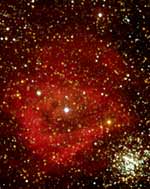
Image credit: ESO
The European Southern Observatory has released new images of nebula N44 in the Large Magellanic Cloud. Astronomers used the ESO’s Wide-Field-Imager on the 2.2 metre La Silla Observatory to capture the area with unprecedented clarity. N44 is approximately 1,000 light-years across and contains about 40 bright luminous blue stars. The blue stars live for a very short time and then explode as supernovae – some have already exploded in the area, creating some of the nebula’s visible material.
The two best known satellite galaxies of the Milky Way, the Magellanic Clouds, are located in the southern sky at a distance of about 170,000 light-years. They host many giant nebular complexes with very hot and luminous stars whose intense ultraviolet radiation causes the surrounding interstellar gas to glow.
The intricate and colourful nebulae are produced by ionised gas [1] that shines as electrons and positively charged atomic nuclei recombine, emitting a cascade of photons at well defined wavelengths. Such nebulae are called “H II regions”, signifying ionised hydrogen, i.e. hydrogen atoms that have lost one electron (protons). Their spectra are characterized by emission lines whose relative intensities carry useful information about the composition of the emitting gas, its temperature, as well as the mechanisms that cause the ionisation. Since the wavelengths of these spectral lines correspond to different colours, these alone are already very informative about the physical conditions of the gas.
N44 [2] in the Large Magellanic Cloud is a spectacular example of such a giant H II region. Having observed it in 1999 (see ESO PR Photos 26a-d/99), a team of European astronomers [3] again used the Wide-Field-Imager (WFI) at the MPG/ESO 2.2-m telescope of the La Silla Observatory, pointing this 67-million pixel digital camera to the same sky region in order to provide another striking – and scientifically extremely rich – image of this complex of nebulae. With a size of roughly 1,000 light-years, the peculiar shape of N44 clearly outlines a ring that includes a bright stellar association of about 40 very luminous and bluish stars.
These stars are the origin of powerful “stellar winds” that blow away the surrounding gas, piling it up and creating gigantic interstellar bubbles. Such massive stars end their lives as exploding supernovae that expel their outer layers at high speeds, typically about 10,000 km/sec.
It is quite likely that some supernovae have already exploded in N44 during the past few million years, thereby “sweeping” away the surrounding gas. Smaller bubbles, filaments, bright knots, and other structures in the gas together testify to the extremely complex structures in this region, kept in continuous motion by the fast outflows from the most massive stars in the area.
The new WFI image of N44
The colours reproduced in the new image of N44, shown in PR Photo 31a/03 (with smaller fields in more detail in PR Photos 31b-e/03) sample three strong spectral emission lines. The blue colour is mainly contributed by emission from singly-ionised oxygen atoms (shining at the ultraviolet wavelength 372.7 nm), while the green colour comes from doubly-ionised oxygen atoms (wavelength 500.7 nm). The red colour is due to the H-alpha line of hydrogen (wavelength 656.2 nm), emitted when protons and electrons combine to form hydrogen atoms. The red colour therefore traces the extremely complex distribution of ionised hydrogen within the nebulae while the difference between the blue and the green colour indicates regions of different temperatures: the hotter the gas, the more doubly-ionised oxygen it contains and, hence, the greener the colour is.
The composite photo produced in this way approximates the real colours of the nebula. Most of the region appears with a pinkish colour (a mixture of blue and red) since, under the normal temperature conditions that characterize most of this H II region, the red light emitted in the H-alpha line and the blue light emitted in the line of singly-ionised oxygen are more intense than that emitted in the line of the doubly-ionised oxygen (green).
However, some regions stand out because of their distinctly greener shade and their high brightness. Each of these regions contains at least one extremely hot star with a temperature somewhere between 30,000 and 70,000 degrees. Its intense ultraviolet radiation heats the surrounding gas to a higher temperature, whereby more oxygen atoms are doubly ionised and the emission of green light is correspondingly stronger, cf. PR Photo 31c/03.
Original Source: ESO News Release
